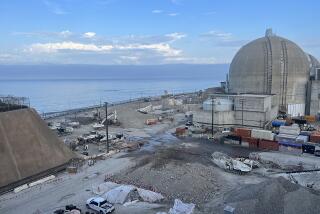In the dark on San Onofre
- Share via
If what two federal lawmakers say is true, there’s more to the shutdown at the San Onofre nuclear plant than the public has been told. According to Sens. Barbara Boxer (D-Calif.) and Edward J. Markey (D-Mass.), a leaked internal report by Mitsubishi Heavy Industries, which manufactured the problem-riddled steam generators that forced the shutdown, indicates that concerns about the generators’ design were raised before they were even installed but that only minimal fixes were made.
Southern California Edison, which owns the plant, denies this, which leaves ratepayers and the public in the dark. They deserve to know more.
San Onofre hasn’t been producing energy for more than a year, ever since it was discovered that vibration in its new $771-million steam generators was causing unusual friction and wear on tubes that carry radioactive water. The utility has asked the Nuclear Regulatory Commission for permission to restart one of the reactors at partial power, saying that the reduced operating level will also reduce vibration.
Boxer and Markey have received copies of the Mitsubishi report, which the NRC also has in its possession, allegedly showing that Edison knew about the design flaws in the steam generators early on. In a letter to the NRC, the two lawmakers contend that the report, the result of an internal corporate probe of the San Onofre fiasco, gives very specific information about early concerns over possible tube friction. Purportedly, Edison rejected any major modifications because they would have required a higher level of regulatory oversight by the NRC. Edison officials contend that the quotations from the report were taken out of context in ways that distort their meaning.
The solution to these warring assertions seems simple enough: Release the report so that ratepayers, who are paying the tab for the purchase of the steam generators, and the public, whose safety depends on responsible operation of the plant, can determine the truth. But the report is stamped “proprietary,” and only Mitsubishi or the NRC can decide to release it.
The NRC should make the document public, and soon. It might provide an important description of how Edison makes its safety decisions, and it could become a key aspect of the Public Utility Commission’s inquiry into whether ratepayers should be forced to continue paying for the steam generators. Any truly proprietary technical data about Mitsubishi’s design methods could be redacted, if they exist. What the public is entitled to is information about who knew what and when.
More to Read
A cure for the common opinion
Get thought-provoking perspectives with our weekly newsletter.
You may occasionally receive promotional content from the Los Angeles Times.










